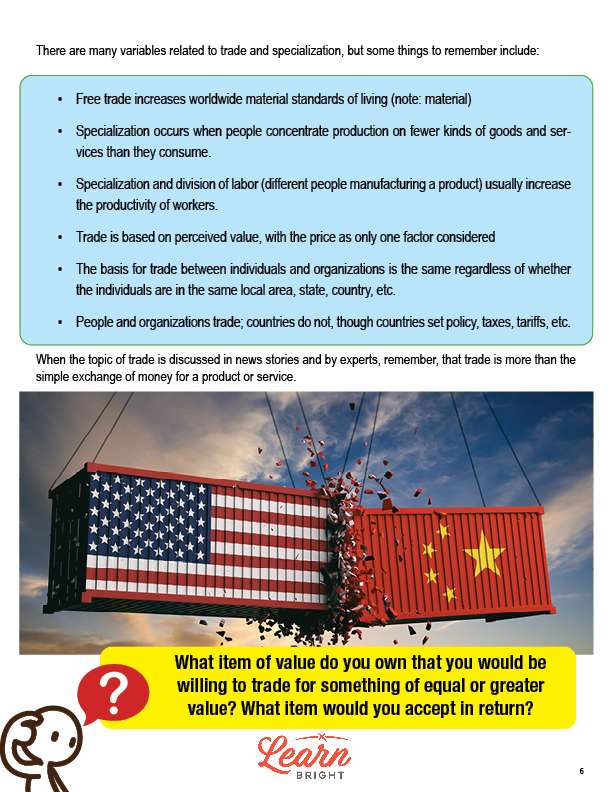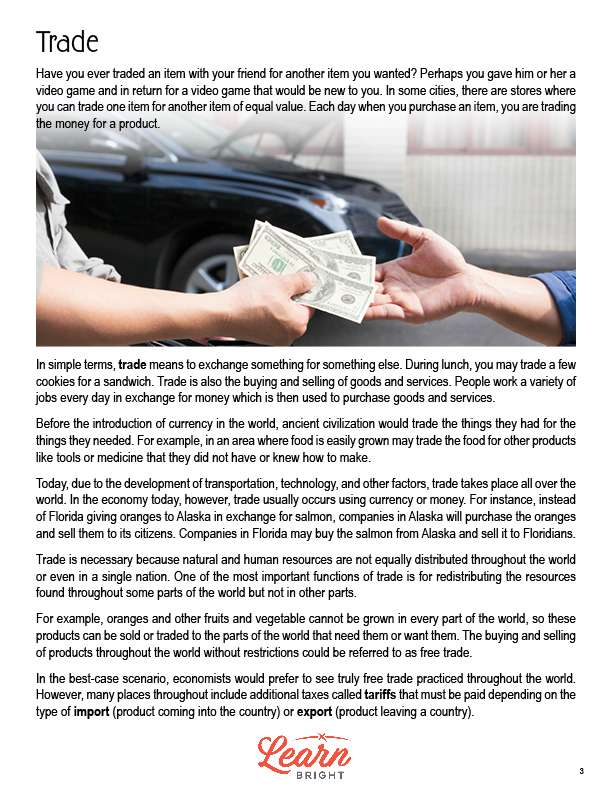Description
What our Trade and Specialization lesson plan includes
Lesson Objective and Overview: Trade and Specialization teaches students about what trade and specialization are and how to understand these concepts in terms of basic economics. At the end of the lesson, students will be able to define trade, specialization, and other related terms and concepts; and explain how trade impacts the cost and price of products. This lesson is for students in 5th grade and 6th grade.
Classroom Procedure
Every lesson plan provides you with a classroom procedure page that outlines a step-by-step guide to follow. You do not have to follow the guide exactly. The guide helps you organize the lesson and details when to hand out worksheets. It also lists information in the orange box that you might find useful. You will find the lesson objectives, state standards, and number of class sessions the lesson should take to complete in this area. In addition, it describes the supplies you will need as well as what and how you need to prepare beforehand. To prepare for this lesson ahead of time, you can copy the handouts.
Options for Lesson
Included with this lesson is an “Options for Lesson” section that lists a number of suggestions for activities to add to the lesson or substitutions for the ones already in the lesson. If you’d like to adjust the lesson activity, you can include more or less questions. For an additional activity, you could play an internet trading game with your students. You could also invite a trade expert to speak to your class about trade, specialization, prices, and more. For another additional activity, you could assign each student two countries and have them compare and contrast their trade policies, imports/exports, and other economic conditions. Finally, you could have your students research the trade practices of early settlers and Native Americans in the United States during Colonial Times and determine how they are the same or different as the policies that exist today.
Teacher Notes
The teacher notes page includes a paragraph with additional guidelines and things to think about as you begin to plan your lesson. This page also includes lines that you can use to add your own notes as you’re preparing for this lesson.
TRADE AND SPECIALIZATION LESSON PLAN CONTENT PAGES
Trade
The Trade and Specialization lesson plan includes four pages of content. You may have traded something for another item you wanted with a friend. Some cities have entire stores where you can trade an item for another one. When you buy something, you’re trading money for that product.
Trade is exchanging something for something else, like when you trade a cookie for a sandwich at lunch. Trade also encompasses buying and selling goods and services. People work in exchange for money, which they then use to purchase things.
Before we had modern forms of currency, civilizations traded what they had for what they needed. If an area grew a lot of food, they could trade that for medicine or other goods that they didn’t know how to make or didn’t have the materials for.
Today, people trade all over the world with the help of modern technology and transportation. However, most trading today happens with money. If Florida gives oranges to Alaska in exchange for salmon, companies in Alaska simply buy the oranges and companies in Florida buy the salmon.
We need trade because resources are not spread evenly throughout the world. Trade helps redistribute resources found in some, but not all, parts of the world. We can’t grow oranges and other fruits and vegetables in every part of the world. This means that we can sell oranges to other parts of the world that want them. We call this buying and selling without restrictions free trade.
Economists advocate for free trade throughout the world. However, many places have taxes called tariffs. You must pay them depending on the type of import (something coming into a country) or export (something coming out of a country). In the previous example, Florida exported oranges and imported salmon; Alaska did the opposite.
Specialization
People sometimes have specialization, or a special skill or talent that someone else might not have, like the ability to play the piano, speak in public well, or play chess.
Economic specialization is when a person, place, or nation decides to specialize in a limited variety of goods. This means that it does not make any other kinds of goods, and instead relies on importing them from other places through trade.
They also consider the cost of producing something. People in other countries made many of the clothes that people in the U.S. wear. It costs less to produce these clothes in other places than in the U.S., mostly due to unfair labor practices.
Countries often buy products from another country that they can sell for a lower price. You might pay $4 for a shirt made in China, but $6 for a shirt made in the United States.
Price is not the only factor when talking about trade and specialization. We also partially determine price by the demand for a product. The higher the demand, the higher the price. Perceived value, or the product’s value based on the opinion of the buyer, is also a contributing factor.
If you like video games, you will place a higher value on a new video game than someone who doesn’t like them. Famous brands can charge more than an unknown brand, because people will pay more for a brand name.
Variables Related to Trade and Specialization
The lesson concludes with some things to remember about trade and specialization.
Free trade generally increases worldwide material standards of living, though only material. Specialization happens when people concentrate on producing fewer goods and services than they use. Specialization and division of labor, where different people manufacture a single product, can increase the productivity of workers. We base trade on perceived value, considering price as one factor. The basis for trade is the same whether the individuals are in the same area or not. Countries do not trade, only people and organizations do. Countries set policy, tariffs, taxes, and more.
TRADE AND SPECIALIZATION LESSON PLAN WORKSHEETS
The Trade and Specialization lesson plan includes three worksheets: an activity worksheet, a practice worksheet, and a homework assignment. You can refer to the guide on the classroom procedure page to determine when to hand out each worksheet.
OPINIONS ACTIVITY WORKSHEET
Students will work with a group to complete the activity worksheet. Each group will discuss five questions with their group, forming an opinion on each. Each student will write their personal response to each question on the worksheet.
Students can also work either alone or in pairs to complete this activity.
MATCHING PRACTICE WORKSHEET
The practice worksheet asks students to first match terms with their definitions. They will then use that list of terms and match them to six scenarios listed on the worksheet, explaining why each scenario matches that concept.
TRADE AND SPECIALIZATION HOMEWORK ASSIGNMENT
For the homework assignment, students will tell whether ten statements are true or false. They will also share their opinions on four questions related to the lesson material.
Worksheet Answer Keys
This lesson plan includes answer keys for the practice worksheet and the homework assignment. If you choose to administer the lesson pages to your students via PDF, you will need to save a new file that omits these pages. Otherwise, you can simply print out the applicable pages and keep these as reference for yourself when grading assignments.









